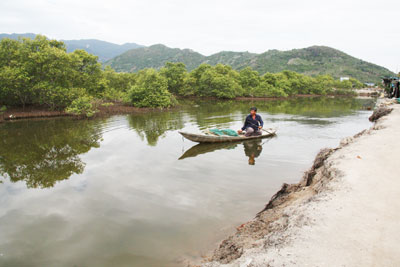
The salt-marsh forests in Ninh Ich Beach (Ninh Hoa Town, Khanh Hoa) have been well growing. The aquatic species raised in these forests have also been bringing profit to the locals.
The salt-marsh forests in Ninh Ich Beach (Ninh Hoa Town, Khanh Hoa) have been well growing. The aquatic species raised in these forests have also been bringing profit to the locals.
Restoring salt-marsh forest
According to Nguyen Van Sang, a resident in Tan Dao Hamlet, the salt-marsh forests in Ninh Ich have been regularly restored. The coastal area in Ninh Ich used to be deforested for shrimp farming; however, nowadays, the locals have restored and protected the salt-marsh forests. The forests are also the shelters and breeding ground for many aquatic species.
Reportedly, before 1995, Nha Phu Swamp had an over-2,000-hectare area of primeval forest. As the industrial shrimp farming strongly developed, the salt marshes were severely deforested. In 2006, Ninh Ich Commune was sponsored by Tokio Marine & Nichido Fire Insurance Co., Ltd. and Hanoi National University of Education to restore five hectares of salt-marsh forest. The commune People’s Committee mobilized the locals to plant additional 10 hectares of salt-marsh forest. Up till now, 20 hectares of salt-marsh forest in Ninh Ich has been restored. Many trees are over 5 m in height and have trunk diameter measured at more than 20 cm.
 |
| Nguyen Van Hoang in the shrimp pond having salt-marsh forests. |
Since the mangrove forests have been restoring and protecting, the ecological environment of the salt-marsh forest in Nha Phu Swamp has positively changed. In rainy season, the shores and ponds have not been eroded away by floods and tides. The aquatic species raised in the forests have also regularly been restored and grown. Therefore, many fishermen have actively engaged in restoring and protecting the salt marshes.
According to Pham Thuc, Chairman of Ninh Ich Commune Farmers’ Association, many models of mangrove forest restoration have been carried out by the locals in Ninh Ich Commune and Ninh Loc Commune. The restoration has taken place right in the shrimp ponds by combining planting mangrove trees and growing aquatic species naturally. As planed, Ninh Ich Commune People’s Committee tries to restore one hectare of salt-marsh forest per year.
Raising aquatic species in salt marshes
Nguyen Van Phai’s family (Tan Dao Hamlet) now has a stable income earning since they started to combine planting salt-marsh forest and raising aquatic species such as crabs and fishes in that forest. According to Phai, the aquatic species living in the salt marshes often have fewer diseases than the ones living in the other places and can be harvested year-round with a low loss ratio.
Reportedly, the aquatic species raised with natural farming methods are sold at a higher price than the ones raised with industrial farming methods.
According to many people in Ninh Ich Commune, the aquaculture in salt-marsh forests requires a low investment cost. The fishermen only have to spend money on buying juveniles. Some people have even taken juveniles from the seas. The forests themselves provide food resource for the aquatic species. However, with this method, the fishermen have difficulty in harvesting because the harvest has to be carried out every day.
“Since the salt-marsh forests have been restored, there are ten households in Tan Dao Hamlet raising aquatic species in the forests with natural methods. At present, the farming area basing on this method is nearly 15 hectares. This method helps the locals to have a stable income and helps to protect the salt-marsh forests. In the upcoming time, we will encourage the locals to carry out this type of breeding,” said Pham Ngoc Khanh, Deputy Chairman of Ninh Ich Commune People’s Committee.
Hai Lang
Translated by H.N




